The typical hearing care professional often works under the assumption that there are literally hundreds of ways to increase revenue in a practice. When faced with so many options, it’s not surprising that many practitioners become paralyzed by the sheer number of choices and fail to take decisive action resulting in revenue growth. The good news is it’s not that complicated. Here’s how to increase your productivity—quickly.
I keep my nose on the grindstone, I work hard every day;
Might get a little tired on the weekend, after I draw my pay;
But I’ll go back workin’, come Monday morning I’m right back with the crew;
I’ll drink a little beer that evening, sing a little bit of these working man blues.
— Merle Haggard

|
| Brian Taylor, AuD is the director of professional and business development for Unitron and its new Unite customer loyalty program. Correspondence can be addressed to HR or . |
You don’t have to enjoy a beer after work to relate to Merle’s classic country tune, Working Man’s Blues. If you’ve ever owned or managed a practice, you know how difficult it is to keep up with the steady flow of patients, while simultaneously creating a credible marketing plan, paying your bills, negotiating hearing aid prices with manufacturers, and devising a long-term strategy that differentiates your practice from the competition.
The objective of this article is to arm the workaday manager with tools to increase the productivity of their practice by focusing on a few simple strategies that will stave off the working person’s blues. Although these strategies may be simple, it’s important not to confuse simple with easy. By rolling up your sleeves, bringing your lunch pail to work (Figure 1), getting some dirt under your fingernails, and taking action, your practice has the potential to experience double-digit growth.
With limited formal business training, the typical hearing care professional often works under the assumption that there are literally hundreds of ways to increase revenue in a practice. When faced with so many options, it’s not surprising that many practitioners become paralyzed by the sheer number of choices and fail to take decisive action resulting in revenue growth.
The good news is it’s not that complicated. No matter what type of practice you own or manage, there are only three things to focus on when trying to increase the overall productivity of your practice: 1) Office traffic, 2) Number of units sold, and 3) Average selling price (ASP). This so-called Productivity Trinity is shown in Figure 2, along with the expected result, if the manager shows up every day and devotes time and resources to improving each of these three dimensions.
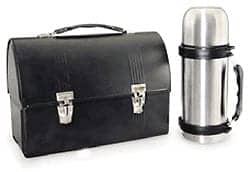
|
| FIGURE 1. Working-person’s lunch pail. The lunch packed inside will give you the energy, tenacity, and diligence you need to bring the tactics in this article to life. |
Before getting into specific actions you can take to increase the productivity of your practice, let’s take a look at some numbers. Just like a construction worker might do some quick calculations of the rise and the run of a specific area in order to determine the correct grade (or slope) of a new road or landscaping feature, you can quickly project how much extra revenue you can generate by plugging in some numbers before you begin work.
This little exercise is a great way to gain a better understanding about how each small improvement along the three dimensions of the Productivity Trinity results in significant top-line revenue growth. According to one survey1 conducted by Unitron, we know the following:
- Average number of prospects visiting an office per month: 42
- Average number of units dispensed per month: 17
- Average selling price per unit: $1,800
- Projected revenue: $367,200
Now let’s see what happens when we simply increase the number of prospects, units sold, and ASP each by a margin of 15%.
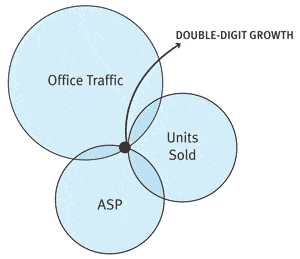
|
| FIGURE 2. Focusing your efforts on the Productivity Trinity of office traffic, units sold, and average sales price is the best way to achieve fast and sustainable practice growth. |
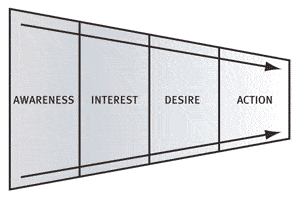
|
| FIGURE 3. The Marketing Funnel envisions the required expenditures for getting a typical consumer to purchase a product or service. It works, but it can be expensive (expense noted by wider portion on the left). |
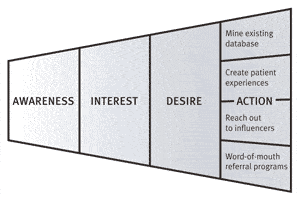
|
| FIGURE 4. Using the power of existing patients allows you to “flip” the Marketing Funnel and significantly reduce your return on marketing investments. |
- Average number of prospects visiting your office per month: 48
- Average number of units dispensed per month: 20
- Average selling price per unit: $2,070
- Projected revenue: $496,800
As you can see, a modest increase of just 15% in each of the three dimensions increases annual revenue by over 30%. In other words, six more patients per month walking through your door, and three additional units per month, results in more than $125,000 in revenue at the end of the year.
So, the real question becomes what are you packing in your lunch pail that will provide this boost in productivity?
Office Traffic
Since 1889, Carhartt has been the leader in durable, premium quality workwear. Whether you are looking for a garment in our signature brown duck fabric or one of our innovative, technically advanced fabrics like Waterproof Breathable, we have the most complete line of workwear available.
—From www.Carhartt.com
Like the logger’s Carhartt jacket, having a steady flow of prospects coming through your door will protect your practice from the elements. In traditional marketing parlance, prospects can become loyal customers through the methodical process depicted in Figure 3.
The Marketing Funnel, which looks more like a bullhorn used by a policeman, would indicate that prospects first have to be aware of, interested in, and desire your services before they will take action by calling your office to schedule an appointment. In fact, the entire advertising profession uses this funnel to create demand for goods and services.
There is no doubt that this approach works. The challenge for the practice manager, however, is that the approach is expensive and inefficient. You can spend significant amounts of cash on advertising and never receive a reasonable return on your investment. Therefore, practice managers need to spend time marketing to their existing database.
A sustainable approach to driving more prospects through your door rests with your ability to flip the marketing funnel. Rather than simply relying on advertising to generate awareness, interest, and desire in your offerings, use the power of your existing patients to create new ones. There are at least four tactics, as shown in Figure 4, you can use to gain new prospects by relying on existing loyal patients:
1) Incentivize word-of-mouth referrals. Word-of-mouth referrals come to your practice with fewer barriers than the typical prospect responding to an ad. Plus, it is essentially no cost from your marketing budget to acquire them. One effective word-of-mouth referral tactic is to offer gift certificates of a nominal amount (eg, $25) to any patient who refers another to your office.
2) Provide an impeccable office experience. This point is directly related to the one above. In order to generate more promoters, your practice has to have an emotional appeal. You can think of the “office experience” as a higher-level, more visceral type of customer service. When you and your staff appeal to the emotions of your prospects, you can more readily solidify your practice as the provider of choice. Entire books2 and Web sites are devoted to improving the office experience in elective medicine. One excellent Web site is www.premiumexperiencenetwork.com. In short, rather than simply focusing on the results of the fitting, you need to focus on the patient’s entire experience with your practice—from the time they picked up the phone until they are a loyal customer and habitual visitor of your practice.
3) Mine your existing database. There are two facts that should motivate you to implement a patient retention program: 1) Over half of all hearing aid purchasers go elsewhere when it’s time to repurchase, and 2) More than 60% of hearing aids are purchased by experienced users. This is why it’s imperative to give patients a reason to come back to your office. Each new product and form-factor launch is an opportunity to inform your patients about improvements that may provide better communication. There is no shortage of office management tools available to you that can help you target a specific group of patients for a flyer or mailing. Some of the latest product innovations are opportunities to mine your existing database by offering an interesting form factor or technological advancement to a precise segment of your database.
4) Reach out to patients and influencers. Even the most well-designed flyers mailed to your database are a passive form of marketing, as it is easy for patients to discard them. You can truly turn the Marketing Funnel into a megaphone by looking for ways to engage your patients in an ongoing dialogue about your practice. There is no shortage of tools and tactics you can use to actively maintain the conversation with prospects and patients.
Measuring patient satisfaction is a great first step. By taking the time to ask your patients and prospects their opinion about how you conduct business, you are able to foster a deeper relationship with them. (Not to mention that patient surveys and focus groups are really the only way to understand what your practice does well and what it needs to improve from a patient’s perspective.) The Web can also be used to maintain the conversation with patients and offer deeper levels of customer service. Video snippets and blogs can be used to educate your patients, and it also allows them to network with other patients dealing with similar issues.
Another proven tactic for maintaining the conversation with your patient base is through public relations opportunities. One growing industry trend is to provide funding for looping systems. In return for funding an induction loop system for a local church or meeting room, you can ask the facility where the loop was installed to provide educational support in the form of lectures or support groups to the members of that facility. The February 2010 issue of The Hearing Review provides details on how to administer a PR campaign around loop systems.3
Finally, a critical part of any patient retention program is reaching out to influencers. An influencer would be defined as anyone who can raise awareness of a condition or assist in the decision-making process of the patient. For example, older adults with hearing loss often rely on their children and even grandchildren for advice about their undiagnosed medical condition.
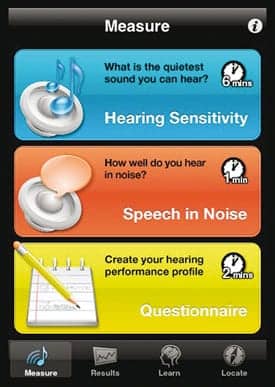
|
| FIGURE 5. The uHEAR application available from iTunes. |
You can reach influencers through public relations campaigns. One interesting tool is the uHEAR (Figure 5), which is an application developed by Unitron and available at iTunes. uHEAR allows people to have their hearing screened with an MP3 player. Since MP3 players are a ubiquitous accessory among people under the age of 30, the uHEAR application is a great way to raise awareness among influencers. Practitioners should be encouraged to develop awareness campaigns that target influencers using uHEAR.
Units Sold
From its birth in the 1920s to its present status as the world’s number-one manufacturer of work apparel, the Williamson-Dickie Mfg Co has earned a reputation for quality workwear that delivers outstanding durability and support. Initially a small family enterprise focused on producing bib overalls, the company grew rapidly and became a major player in the uniform apparel market, and in World War II millions of soldiers wore uniforms bearing the Williamson-Dickie label of quality.
—From www.dickies.com
Perhaps the single greatest opportunity to increase revenue in your practice is by gaining a buying commitment from just one or two prospects each month. According to at least one industry survey,1 the number of prospects who are motivated to purchase and actually decide to buy at the time of their consultation appointment is around 40%. This would suggest that over half of all prospects going through a 60- to 90-minute appointment are walking out the door without agreeing to purchase hearing instruments. Clearly, there is an opportunity to increase productivity through better management of the consultation appointment.
If you were a farmer back in 1920, chances are pretty good that you wore a pair of Dickies bib overalls while you sat on your steel wheel tractor. Times have certainly changed. There are a lot less farmers today and the ones who still toil often do it from temperature-controlled climes of a cab on the tractor—where shorts and a t-shirt are perfectly acceptable attire.
The consultative audiology process is similar. Advances in diagnostic and hearing aid fitting technology have rendered some tests obsolete. Like the popular bib overalls of the 1920s, there are some components of the consultative test battery that have been modernized. Unfortunately, many professionals still rely on outdated testing procedures for making important clinical decisions and establishing relationships with patients.
Based on research findings,4-6 there are at least two clinical tests that can be used to better understand the impaired auditory system. In addition, because these pre-fitting tests simulate real-world listening, they allow the patient to participate in the process in a far more meaningful way. The two pre-fitting tests are the Quick SIN7 and Acceptable Noise Level (ANL) Test.8 Both tests not only provide important diagnostic information, but they allow the professional to be more persuasive.
When you boil it all down, professionals who are successful in the commercial hearing aid dispenser sector of the market have two skills that make them persuasive:
- Relationship building skills
- Technical ability
When both these skills are in abundance, professionals have the innate ability to gain agreement from patients. For the rest of us who may not be so lucky, we can learn to be more persuasive. Robert Cialdini has written extensively about the “six weapons of influence”9:
1) Reciprocation. All of us are taught we should find some way to repay others for what they do for us. Most people will make an effort to avoid being considered a person that doesn’t return a favor. Providing patients useful educational information about the consequences of untreated hearing loss is one of the best ways to leverage the concept of reciprocation.
2) Commitment and consistency. Once people have made a choice, they are under both internal and external pressure to behave consistently. No one wants to be labeled a hypocrite. When you get someone to commit verbally to an action, the chances of them actually doing it go up considerably. Breaking the pre-fitting consultation into a series of “next steps” in which you ask the patient’s permission to move to the next step is a great way to capitalize on the concept of commitment and consistency.
3) Social proof. We decide what is correct by noticing what other people think is correct. Professionals can use testimonials during the consultation as evidence that other like-minded patients are satisfied with their decision to do business with you.
4) Liking. People love to do business with people they enjoy being around. Taking the time to flatter your patients during their appointments, often referring to them by name, and providing a memorable office experience for the patients are examples of the liking principle.
5) Authority. Most people have a respect for authority figures. You can put this principle to good use by wearing a lab coat (implied authority) and by effectively communicating the research that supports your recommendation for the patient (real authority).
6) Scarcity. Opportunities seem more valuable when they are less available. Things that are hard to get are perceived as having more value. You can leverage the Scarcity principle by referring to the limited resources and time that might be available to help a patient. For example, your receptionist uses the Scarcity principle when she mentions to a patient that your schedule is really full and it’s best to get some time booked now, rather than waiting.
Average Selling Price

|
| FIGURE 6. Value-added items and programs offered by your practice are what determine the amount you can justify when raising the retail price above the wholesale price. The amount of value for each dollar the customer pays plays a major role in how they perceive your services—and their recommendations to others. |
In a high-margin/low-volume business like hearing aid dispensing, managing your average selling price (ASP) can have a huge impact on business. Rather than thinking about ASP increases as simply “raising prices on my patients,” let’s examine how practitioners can add value at specific price points without lowering prices.
Figure 6 illustrates the value-added concept. No matter what your patient mix and price strategy, all managers work with a wholesale and retail price (represented by the floor and ceiling in Figure 6). The real opportunity is to maintain a healthy margin and to fill this margin with as much value as possible. Value can take the form of extra time spent with patients or providing additional services.
Many professionals make the mistake of equating value with technology. Improved technology has certainly created an opportunity for offering products at a higher retail price, but don’t be fooled into thinking that all of the value is related to the technology supplied to us by our manufacturing partners. Professionals need to relentlessly look for ways to add value by improving service and the overall office experience. There are at least three tactics you can employ that add value and allow you to command a higher ASP:
1) Offer comprehensive follow-up services. A good example of a value-added program is LACE offered from Neurotone.10 For a small investment—which can be bundled into the price of the purchase—patients are able to complete 10 or more training exercises. Since the exercises are self-guided, the practice manager does not have to devote staff time to the program.
2) Spend more time conducting computerized testing. A recent Hearing Industries Association study11 shows that patients are more likely to report higher levels of satisfaction when professionals spend more face time with the patient and use computerized testing, like probe microphone analysis, as part of the testing process.
3) Add more touchpoints. This simply means that you are giving patients more direct access to your practice. Touchpoints can include annual check-ups, follow-up appointments, and visits to your Web site to obtain information and to purchase accessories like batteries. Another way to add touchpoints is by hiring a hearing aid wearer you fitted to conduct support groups for your practice.
The bottom line is that you can add value by making your practice more accessible to your patients.
Your Path to Success
Several ideas for increasing productivity in a practice have been presented here, each of them addressing one of the three parts of the Productivity Trinity: office traffic, units sold, and ASP. Once you have decided you need to increase productivity, you can put this 5-step plan to work for you:

|
| FIGURE 7. The Practice Oriented Scale of Improvement Tool (for a copy, download the pdf here). |
Step 1. Identify the gaps in productivity through benchmarking your practice against some industry averages.
Step 2. Understand how each of the four walls of your practice (people, process, financials, and sales/marketing tactics) contributes to current productivity.
Step 3. Uncover the root causes of your productivity gaps by brainstorming all of the causes and effects of the productivity gaps in your practice. Once you have listed all the possible causes of a productivity gap, you can prioritize them.
Step 4. Conduct a POSI (Figure 7), then develop clear goals and an action plan that addresses each of the causes of the productivity gap.
Step 5. Execute the plan and monitor results.
This 5-step process, called the Business Compass, allows the busy practice owner to maintain a laser-like focus on seeing patients, while enjoying the expert insights of a business specialist who can assist with boosting productivity. Many practitioners are familiar with the Client Oriented Scale of Improvement (COSI), which is commonly used to assess and prioritize the communication needs. Unitron has developed the Practice Oriented Scale of Improvement (POSI) to help practitioners target and prioritize the needs of their practice.
You don’t have to have an MBA to reap the rewards of a business specialist. It all starts with putting on your Carhartt jacket and Dickie’s bib overalls, and bringing your lunch pail to work—and then keeping your nose to the grindstone.
Acknowledgement
The author acknowledges Scot Frink, AuD, of Salem, Ore, for coining the term POSI.
References
- Taylor B. Survey of current business practices reveals opportunities for improvement. Hear Jour. 2009;62:9,24-31.
- Pine BJ, Gilmore JH. The Experience Economy. Boston: Harvard Business School Press; 1999.
- Myers DG. Progress toward the looping of America—and doubled hearing aid functionality. Hearing Review. 2010;17(2):10-17.
- Nabelak A. Acceptable noise level: a clinical measure for predicting hearing aid outcome. J Am Acad Audiol. 2006;17(9):626-639.
- Wilson RH, McArdle RA, Smith SL. An evaluation of the BKB-SIN, HINT, QuickSIN, and WIN materials on listeners with normal hearing and listeners with hearing loss. J Speech Lang Hear Res. 2007;50(4):844-856.
- Mueller HG, Johnson E, Weber J. Fitting hearing aids: a comparison of three pre-fitting speech tests. Available at: www.audiologyonline.com/articles/article_detail.asp?article_id=2332. Accessed March 29, 2010.
- Etymotic Research. QuickSIN Speech in Noise Test. Elk Grove Village, Ill: Etymotic Research. Available at: www.etymotic.com/pro/quicksin.aspx. Accessed July 15, 2010.
- Frye Electronics. The Acceptable Noise Level (ANL) Test. Tigard, Ore: Frye Electronics. Available at: www.frye.com/products/analyzers/ANLT.html. Accessed July 15, 2010.
- Cialdini R. Influence: Science and Practice. New York City: Allyn & Bacon; 2001.
- Sweetow R. Physical therapy for the ears: maximizing patient benefit using a listening retraining program. Hearing Review. 2005;12(10):56-58. Accessed July 15, 2010.
- Rogin C. Top 10 Reasons for Hearing Aid Delight. Washington, DC: Hearing Industries Association; 2010.
Correspondence can be addressed to HR or Brian Taylor, AuD, at .
Citation for this article:
Taylor B. A working-person’s guide to quality and productivity, Part 2: How to increase productivity in your practice. Hearing Review 2010;17(9):14-24.





